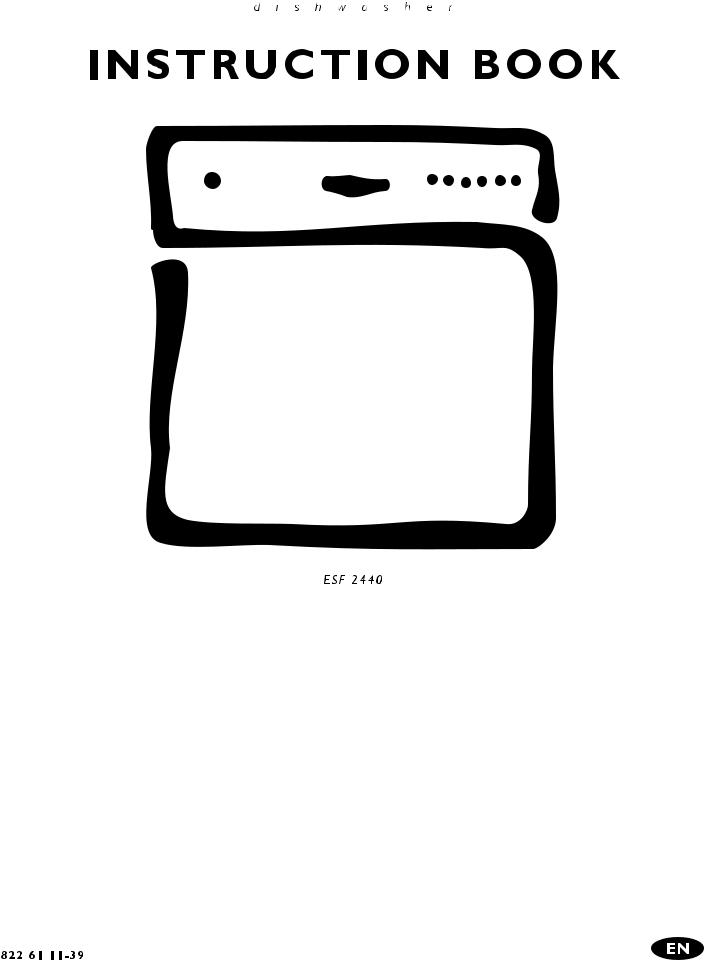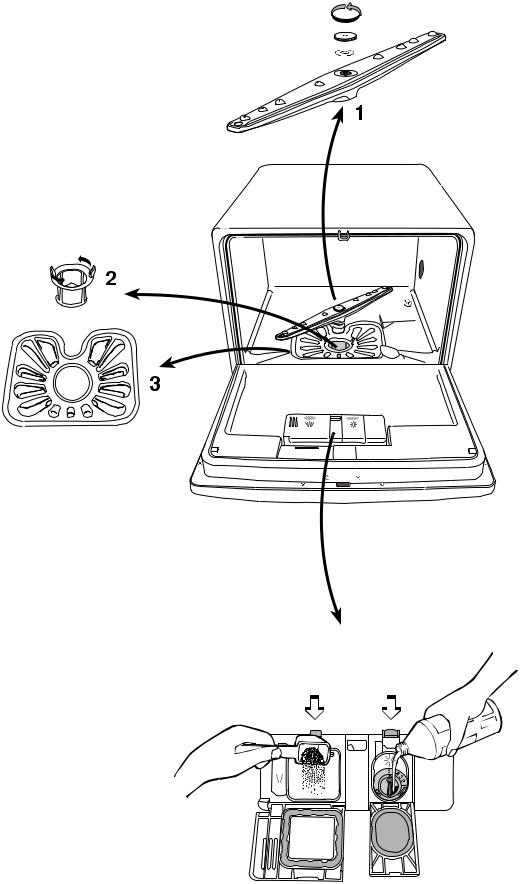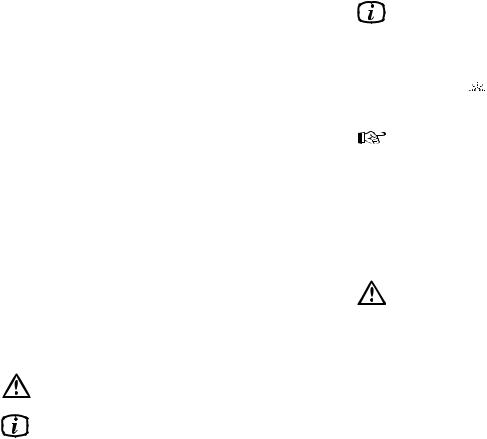AEG-Electrolux ESF2440 User Manual


Contents
For the user
Safety information |
3 |
Description of the appliance |
4-5 |
-Spray arm
-Coarse filter/microfilter
-Fine filter
-Detergent dispenser
-Rinse aid dispenser
The control panel |
6 |
- How to set the delayed start |
|
Programme chart |
7 |
Loading and unloading |
8 |
Using the appliance |
9 |
-Starting the programme
-Interrupting the programme temporarily
-Cancelling the programme
-Pause function
-Cancelling the drying phase
-Switching the dishwasher off
-Cleaning the dishwasher
In the event of a fault |
10-11 |
Service |
12 |
- Service and spare parts |
|
Information for test centres |
12 |
For the installer
Technical specifications |
13 |
Unpacking |
14 |
-Damages
-Use
-Positioning
-Protecting the dishwasher against freezing
Installation |
15 |
-Water inlet
-Water drainage
-Electrical connection
Guide to use the instruction book
The following symbols will be found in the text to guide you throughout the instructions:
Safety information
Step by step instructions
Hints and tips
Environmental information
- 2 -

 Safety information
Safety information
Before installing and first using the dishwasher, read this instruction booklet carefully, including its hints and warnings. To avoid unnecessary mistakes and accidents, it is important to ensure that all people using the dishwasher are thoroughly familiar with its operation and safety features. Save these instructions and make sure they remain with the dishwasher if it is moved or sold, so that everyone using it through its life can be properly informed on appliance use and safety.
Installation and servicing
●All installation and service work done on the product must be carried out by a qualified technician. Work performed by persons with inadequate knowledge may adversely affect the satisfactory functioning of the product and may cause personal injury or damage. Before any work is carried out on the dishwasher, it must be isolated from the electrical supply, by unplugging the power cord or removing the fuse.
●Water connection shall be made via an easily accessible stopcock.
●The power cord must be plugged into an earthed socket, which need to be easily accessible. Permanent installation must only be carried out by an authorised electrician or competent person.
●If the power cord is damaged, it must be replaced by a special cord or assembly available from the manufacturer or its service agent.
●Make sure that the power cord is not nipped or otherwise damaged and that the hoses do not get crushed or kinked when moving the dishwasher in connection with installation or cleaning etc.
●Servicing and possible repairs must be carried out by a service company authorised by the supplier. Use only spare parts supplied by these. Never try to repair the dishwasher yourself.
Child Safety
●The dishwasher should be used by adults only. Do not let children play with the controls or other parts of it.
●Remember that the plastic bags included in the packaging can be fatal playthings for small children.
●Keep all detergents in safe place out of children´s reach.
●Prevent children from sitting, swinging or standing on the open door.
During Use
●This dishwasher is designed solely for washing household utensils suitable for machine washing. Using it for other purposes could lead to physical injury or damage to property and invalidate the guarantee.
●Avoid opening the door while the dishwasher is running, since hot steam may escape.
●Only use detergent specifically designed for use in dishwashers.
●Do not place sharp knives with their points upwards. It is much safer to lay them horizontally in the basket.
●Ensure that the door of the dishwasher is always closed when it is not being loaded or unloaded. In this way you will avoid anybody injuring themselves on the open door.
●If you take any dishes out of the dishwasher before the end of the dishwashing cycle, it is extremely important to rinse them thoroughly under running water to remove any remaining detergent.
●The water safety system protects against water damages. The following requirements must be fulfilled:
-The dishwasher must be electrically connected when it is shut off.
-The dishwasher must be correctly installed.
-Always shut off the water supply whenever the dishwasher is left unattended for an extended period.
●In the event of flooding or leakage, shut off the water supply immediately by closing the stopcock and disconnect the power supply by unplugging the power cord or removing the fuse. When removing the electrical plug, grip the plug, not the lead.
Disposal 
- packaging:
All materials used in packaging this appliance are environmentally-friendly. The various plastics used are identified and can be recycled:
●PE stands for polyethylene, which is used for the bag around the appliance and the bag in which these instructions were supplied.
●PS stands for polystyrene (moulded), which is used for the sections of packaging needed to cushion the appliance.
The cardboard components of the packaging are made from recyclable paper and should be taken to a collection point for recycling.
- old apparatus:
The symbol on the product or on its packaging indicates that this product may not be treated as household waste. Instead it shall be handed over to the applicable collection point for the recycling of electrical and electronic equipment. By ensuring this product is disposed of correctly, you will help prevent potential negative consequences for the environment and human health, which could otherwise be caused by inappropriate waste handling of this product. For more detailed information about recycling of this product, please contact your local city office, your household waste disposal service or the shop where you purchased the product.
- 3 - |
822 61 11-39 |

Description of the appliance
4 5
- 4 -

Description of the appliance
Spray arm (1)
It is important to keep all the holes in the spray arm clear. A clogged hole can seriously affect washing efficiency.
If the spray arm needs cleaning, unscrew the nut anticlockwise, remove the washer and lift off the spray arm. Clear the holes and shake out any food remnants.
Coarse filter/microfilter (2)
The purpose of the coarse filter is to catch large objects such as toothpicks and pieces of eggshell. Make sure that the filter is always clean. Turn the coarse filter anticlockwise. Lift it out and rinse it under running water whenever necessary.
Fine filter (3)
It is just as important to keep this filter clean. A dirty or clogged filter will always impair washing efficiency. The fine filter can easily be lifted out for cleaning when you have removed the coarse filter.
Rinse aid dispenser (5)
Use of rinse aid will result in cleaner and faster drying of the load, since it helps water and soil to run off.
Too much rinse aid may result in streakiness, too little may cause white spots. The dispenser holds about 150 ml. This is enough for approx. 60 wash cycles, depending on the dosage setting. Adjust the dosage setting according to the hardness of the water.
You can set the dosage between 1 - 6, equivalent to 1 - 6 ml rinse aid. Factory setting is 1.
Begin at the lowest dosage setting and increase if necessary by turning the setting arrow with e.g. the handle of a spoon.
The indicator light  on the control panel is lit when the dispenser requires refilling.
on the control panel is lit when the dispenser requires refilling.
1. Open the lid to the dispenser by pressing the lid catch towards the compartment and lift the lid.
2. Fill up with rinse aid; do not overfill.
Detergent dispenser (4)
Open the lid to the dispenser by pressing the lid catch towards the compartment. Consult the instructions on the detergent packet, fill the compartment accordingly and close the lid. Remember that the instructions usually refer to full-size dishwashers, for example when using detergent tablets, it is sufficient to use just half a tablet. Pre-wash detergent is poured into the smaller compartment to the left when needed. This detergent is active allready at prerinsing. Make sure that there is no items that prevents the lid from opening.
Only use detergents specially designed for dishwashers.
Avoid frequent use of liquid detergents, as the long term effects of such detergents create a potential risk of increasing pump noise.
3.Wipe off any spillage carefully to prevent excessive foaming during the next wash programme.
4.Close the lid and press until it locks again.
Do not fill the rinse aid dispenser with liquid detergent.
- 5 -
